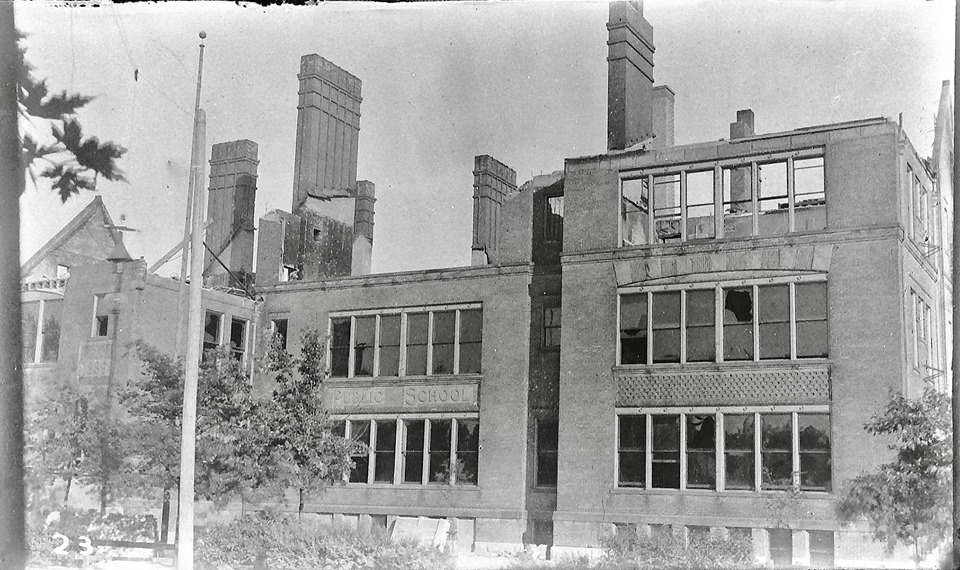There's no such thing as a quick visit to the MPS facilities and maintenance department's archive on the edge of Downtown. At least not for a schoolhouse geek like me.
Recently, I stopped in to see if I could glean some information about who created the gorgeous decoration at the shuttered Philipp Elementary and, as always, one thing led to another and I found myself over by the Ds in the alphabetized flat files that hold the drawings for all buildings still under the district's purview.
As the debate about the future of the currently idle Dover Street School building in Bay View continues, I decided to take a look at what the building was intended to look like and how it changed.
There has been some debate about whether or not Edward Townsend Mix or his partner Walter Holbrook drew the plans for Dover Street School, which was designated District 17 No. 1 until 1912.
Mix, one of the most respected – if not the most respected – architects in Milwaukee at the time, and Holbrook were partners from 1882 until 1889, so perhaps the argument is a moot one. Maybe the two – both of whom had drawn a number of public schools (Holbrook was responsible for two other Bay View schools: Mound Street and Trowbridge) – collaborated.
What was drawn was a lovely Queen Anne-style, three-story schoolhouse executed in cream city brick with rusticated stone details. An entry tower on the east end surely suggests Mix – as does the fact that his name alone is on the plans – especially when compared to his Second Ward School on 10th and Highland.
That school, attributed to Mix, was also built in 1889 and looked very similar to the plan for Dover, though a bit larger and reversed. It has a nearly identical tower. You can see a photo of that building, long since razed, here.
Like most neighborhood schools, District 17 – which had itself replaced a smaller schoolhouse on the site – was woefully inadequate in size by 1909, when an addition was put on the back. Part of that addition was the incredible basement kindergarten room (above), with its fan of south-facing windows offering scads of natural light.

(PHOTO: Courtesy of Terry Johannes)
But the following June, fire tore through the building, causing extensive damage to the roof and attic floor. According to Ron Winkler's Bay View book in Arcadia's "Images of America" series, damage ran more than $23,000. That was roughly the amount the district was spending just a few years earlier to erect an entire three-story brick schoolhouse.
So, architects went back to the drawing board and made do. Rather than restore the school to Mix's plans they trimmed off the remaining gables and dormers and filled in destroyed portions of the third floor exterior to create the flat-roofed school that we see today.
On those drawings, specifications called for "each contractor (to) remove all material belonging to his work damaged by fire or water throughout the building and replace with material of same quality and shape as origonaly (sic) used or as directed. Study drawings an (sic) building carefully.
"The printed specifications for the additions built last year shall govern the quality of the work and material used for this reconstruction. Mason to build up brick work with hard burned common brick laid in strong cement mortar."
It's not clear who drew the 1909 and 1910 plans, but we know it wasn't Mix, who died in September 1890 in Minneapolis, where he was then living.
Steel trusses – by 1910 more common – replaced the web of carpentry that supported the old gabled roof.
Those repairs brought Dover Street School back to life and it spent the next century serving the children of Bay View, or at least the ones who were subject to taunts like "Dover, Dover stinks all over; put in the can and roll them over" from their equals over at Fernwood and other neighborhood schools.
Born in Brooklyn, N.Y., where he lived until he was 17, Bobby received his BA-Mass Communications from UWM in 1989 and has lived in Walker's Point, Bay View, Enderis Park, South Milwaukee and on the East Side.
He has published three non-fiction books in Italy – including one about an event in Milwaukee history, which was published in the U.S. in autumn 2010. Four more books, all about Milwaukee, have been published by The History Press.
With his most recent band, The Yell Leaders, Bobby released four LPs and had a songs featured in episodes of TV's "Party of Five" and "Dawson's Creek," and films in Japan, South America and the U.S. The Yell Leaders were named the best unsigned band in their region by VH-1 as part of its Rock Across America 1998 Tour. Most recently, the band contributed tracks to a UK vinyl/CD tribute to the Redskins and collaborated on a track with Italian novelist Enrico Remmert.
He's produced three installments of the "OMCD" series of local music compilations for OnMilwaukee.com and in 2007 produced a CD of Italian music and poetry.
In 2005, he was awarded the City of Asti's (Italy) Journalism Prize for his work focusing on that area. He has also won awards from the Milwaukee Press Club.
He has be heard on 88Nine Radio Milwaukee talking about his "Urban Spelunking" series of stories, in that station's most popular podcast.







